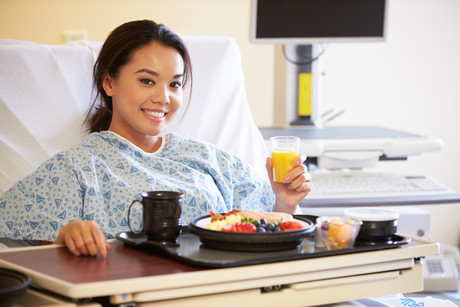Do you want to provide food or do you want your patients to eat?

In June 2013, Mater Private Hospital Brisbane implemented an innovative 5-star hotel-inspired food service model, allowing patients to choose their meals when they feel like it.
Mater was the first hospital in Australia to offer this hotel-style room service to patients and following significant improvement in key outcomes, the service was extended across Mater’s South Brisbane campus in 2016. The response from patients has been overwhelmingly positive and it is not only changing the way patients feel about hospital food but is also decreasing waste, improving patients’ nutritional intake and adding to the organisation’s bottom line.
Driven by a desire to create a better service for patients, ‘Room Service’, which enables patients to order from a personalised clinically appropriate menu, was implemented through a strong collaboration between Nutrition and Dietetics, and Food Services.
Like many hospitals in Australia, prior to implementing Room Service there was a fully manual, paper-based model in place. Patients completed their menu choice well in advance of the mealtime, often with little interaction with staff. Traditional set meal times were scheduled with dinner being served as early as 5.30 pm. Many late and extra meal deliveries were required as a result of these ordering practices.
Under this model, patient satisfaction with food was rated poorly during feedback surveys, their nutritional intake was suboptimal and high levels of plate and kitchen waste were also recorded.
Room Service is a system most commonly seen in the USA and more closely resembles a hotel-style model than a hospital food service system. One a-la-carte style menu integrates therapeutic diets with educational symbols used to assist patients understand appropriate choices. Patients order their meals anytime between 6.30 am and 7 pm via trained call centre staff and their meal is prepared fresh and delivered within 45 minutes.
The model is underpinned by a sophisticated electronic menu management system that monitors meal choices for every patient, ensuring that patients receive options compatible with their medical condition, but also alerts staff if patients miss meals and allows their nutritional intake to be consistently monitored. This is increasingly important with prevalence of malnutrition in hospitals averaging 30%.
Four key measures were developed and documented in Mater’s Room Service balanced scorecard:
- Patient satisfaction via external and statewide benchmarking tools.
- Nutritional intake via CBORD Mobile Intake software and patient consumption data.
- Plate waste and reasons for waste through observation and patient interviews.
- Kitchen food cost savings.
While nutritional intake has significantly increased in the Room Service model, there has also been a consistent 20% reduction in total food costs and an average 17% reduction in plate waste, compared with the traditional model. Some of the greatest plate waste reductions have been seen in patient groups who are the most difficult to feed, such as the oncology population, which recorded an average plate waste at 9%.
Reduced overall waste and cost savings are due to reduced stock holding and kitchen waste in the move to the cook-on-demand model, rather than predicting patient choices in advance. Use of the sophisticated electronic menu management system allows quick and easy menu changes to be made using patient preference data according to popular or unpopular items and can also be adjusted to incorporate seasonal produce, further reducing costs of food purchased.
Patient surveys have seen satisfaction with the quality and flavour of the food increased to be within the top 5–10% of peer hospitals.
There has been a clear meal order pattern when patients are left to order their meals themselves which has also assisted to reduce unnecessary food waste. There has been a reduction in snack items delivered at traditional mid-meal times yet despite this, total daily nutritional intake has increased as patients consume almost all of the food when they do order.
The number one lesson learned is that if patients are left to decide for themselves what and when they will eat (within medically determined diet restrictions), their satisfaction increases, their nutritional intake increases and waste and costs decrease. The implementation of a sophisticated electronic menu system coupled with an agile cook-on-demand model allows a customer-focused, clinically appropriate and safe food service model to be implemented across a wide range of patient groups with varying individual needs.
 *Sally McCray is an Accredited Practising Dietitian and the Director of Nutrition and Dietetics at Mater Group. She has worked within clinical dietetics for the past 20 years in a number of hospitals throughout Queensland as well as in Canada. She has also had experience working within a number of different healthcare foodservice production and delivery models as well as in restaurant and hotel foodservice environments.
*Sally McCray is an Accredited Practising Dietitian and the Director of Nutrition and Dietetics at Mater Group. She has worked within clinical dietetics for the past 20 years in a number of hospitals throughout Queensland as well as in Canada. She has also had experience working within a number of different healthcare foodservice production and delivery models as well as in restaurant and hotel foodservice environments.
 Sally McCray is an Accredited Practising Dietitian and member of the Dietitians Association of Australia’s Food Service Interest Group. To find an Accredited Practising Dietitian (APD), visit the ‘Find an APD’ page of the DAA website at daa.asn.au or call 1800 812 942.
Sally McCray is an Accredited Practising Dietitian and member of the Dietitians Association of Australia’s Food Service Interest Group. To find an Accredited Practising Dietitian (APD), visit the ‘Find an APD’ page of the DAA website at daa.asn.au or call 1800 812 942.
What's new on the shelf
From classic reinspired ice cream to West African flavours in a jar and whiskey aged in a gaol,...
What's new: six on the shelf
From classic chocolatey flavours reinspired to Korean delicacies, have a look at what's new...
What's new on the shelf?
From Aussie/American fusion-inspired hot sauce to a canned protein drink for gamers, have a look...











